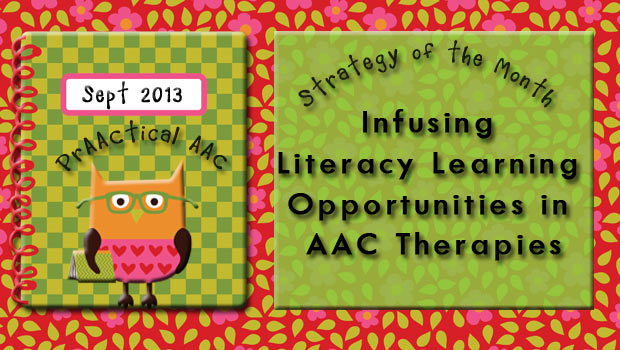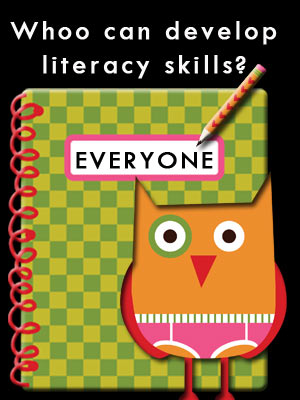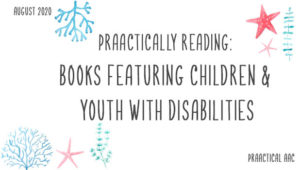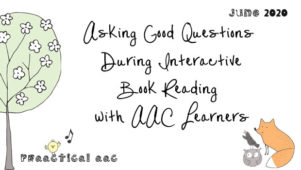Infusing Literacy Learning Opportunities in AAC Therapies

Most of our conversations with SLPs about teaching literacy to individuals with AAC needs revolve around the ‘How’s.”
- “How can I possibly teach reading and writing? I don’t have enough time with her to teach language and communication!”
- “How am I going to teach reading to someone who can’t sound out words? Or writing to someone who can barely use a pencil or keyboard?”
In general, SLPs WANT to teach literacy skills. They understand the importance of this skill set and how it can level the playing field for people with communication difficulties. They know that reading and writing are inherently linked to speaking and listening. They know that literacy is a powerful key that unlocks many, many doors. And yet, getting from there to the point of actually teaching clients with AAC needs to read and write is not something we do enough of. This month, we’ll look at ways to infuse literacy learning opportunities into our AAC therapies.
from there to the point of actually teaching clients with AAC needs to read and write is not something we do enough of. This month, we’ll look at ways to infuse literacy learning opportunities into our AAC therapies.
We are fortunate to be practicing at a time in which there is a growing number of resources for how to best provide literacy instruction to people who use AAC. The Center for Literacy and Disability Studies at the University of North Carolina-Chapel Hill and the AAC Program at Penn State University both generate research and related materials that has guided many AAC practitioners. Likewise, SLPs, such as Jane Farrall and Caroline Musselwhite have generously shared their prAACtical perspectives on the role of literacy instruction in the lives of individuals who use AAC. We are deeply grateful to all of them, and several others, for the work that they do.
“How do I add (more) literacy learning experiences to my AAC therapy?” This is a question that (a) we ask ourselves quite often, (b) ask our graduate students to ask themselves, and, (c ) try to answer. Our AAC clients are complex and unique, so the answers can take some time to formulate. It is a complex task but one so important that we cannot avoid tackling it.
Comprehensive literacy programs are multi-faceted. Over a decade ago, the National Reading Panel (NRP) delineated five areas for reading instruction. People who use AAC, like anyone else, may need instruction in each area and in writing as well. Here are some of the things we think about as we are addressing the ‘how’ question with the needs of a specific AAC learner in mind.
Phonemic Awareness
Phonemic awareness (PA) is something quite familiar to most SLPs. In involves building an awareness of the smallest units of spoken language (phonemes), and being able to manipulate them in words. For most children, it serves as a foundation on which skills in spelling and decoding are built. Penn State’s website on literacy instruction for people who use AAC has excellent suggestions for building PA skills, specifically sound blending and segmenting phonemes.
Phonics
Phonics instruction involves understanding the relationship between letters and sounds, and knowing how those are used in reading and spelling. It is best taught systematically, with a carefully sequenced process. Many SLPs have worked in the classroom that used the process described by Light and McNaughton* and Cunningham’s ideas for phonics instruction (Systematic Sequential Phonics They Use) with good success.
Vocabulary
In the context of literacy learning, vocabulary instruction refers to recognizing words in text and understanding them. As we’ve said previously in this space, AAC learners need both explicit instruction and indirect methods of building their understanding of new words. Repeated contact with the target words and practice in using those words are critical for meaningful skill acquisition to occur. The process we’ve described for vocabulary instruction addresses both things.
Fluency
Fluency in reading refers to the ability to read with speed, accuracy, and expression and is generally measured by listening to children read out loud. That makes it a bit problematic for individuals who cannot speak in sentences. Light and McNaughton discuss a process for helping learners to read sentence and short stories that is worth considering for many of our AAC clients. In many cases, we focus on silent reading comprehension and the use of an inner voice when reading.
Comprehension of Text
Knowing how to use specific strategies to understand text is another important part of a comprehensive reading program. The process described by Light and McNaughton for building comprehension can be helpful for many learners and is very straightforward in its implementation. We’ve also utilized many of the ideas discussed by Erickson, David Koppenhaver, and their colleagues for activating and building background knowledge, setting a purpose for reading prior to beginning, and following up with text-related activities. This handout by Dr. Caroline Musselwhite has some excellent ideas for helping people who use AAC gain skills with reading comprehension.
Writing
While not addressed as a specific domain area, the NRP recognized that writing instruction is solidly connected to most of the reading skills that were already discussed. The concept of alternative pencils is a wonderful starting point, but only addresses the mechanics of writing. The harder part, and the one that needs our attention, is helping learners grow in their ability to translate thoughts into printed words.
Throughout September, International Literacy Month, we’ll be posting resources and strategies for SLPs who plan to infuse more literacy instruction into their supports of individuals with AAC needs. Do you have a success story to share about the literacy learning of a client who uses AAC? We’d love to hear about it.
::::::::::::::::::::::::::::::::::::::::::::::::::::::::::::::::::::::::::::
* The full curriculum based on this approach is available from DynaVox Mayer Johnson here.
National Reading Panel. (April, 2000). Report of the National Reading Panel. Teaching Children to Read: An Evidence-Based Assessment of the Scientific Research Literature on Reading and Its Implications for Reading Instruction. National Institute of Child Health and Human Development.
You can access it online here: Teaching Children to Read
Filed under: Strategy of the Month
Tagged With: literacy, reading, writing
This post was written by Carole Zangari





9 Comments
Your blog/twitter feed and resources give me daily doses of inspiration in bite-sized portions. I am very grateful for your efforts and contributions to my professional development. I am about to share this post with a teacher who just asked me about her student who is in first grade and on her journey to literacy. Thank you.
What a lovely thing to say! It is SUCH a compliment especially coming from you, Sally! Aren’t we lucky to be in a field where people share their ideas so freely? We are all learning and figuring things out together. Thanks for taking the time to stop by and comment!
Our Assistive Technology Team creates a Strategy-A-Day calendar each year. We also print it (thanks to our Vo Tech students) and distribute it in a hard copy form to our Special Ed and new teachers. http://lcps.org/Page/109839 I am currently creating my slides for the 14-15 calendar. Your Facebook feed is also a treasure trove of resources. Thank you for making my job easier!
Thanks for that link, Sally. I am checking it out right now and drooling over all the goodies. Is there a way for us to print some of the calendar pages or is that just for your own staff? Great stuff!!
Thank you! I will pass on your praise to the AT Team. On page 3 of the calendar we have explained our copyright policy so…just “right-click and save as ” . Your interest means a lot to us!
Wonderful! Thanks, Sally!!
nice post.
Are there updated links? For example the Jane Farrall link, the blending link, etc?
Lily, thanks for your questions. This is an old post but I did find and update some of the links. E.g., http://www.janefarrall.com/html/literacy.html ; http://aacliteracy.psu.edu/index.php/page/show/id/4/index.html Hope you find them to be helpful!